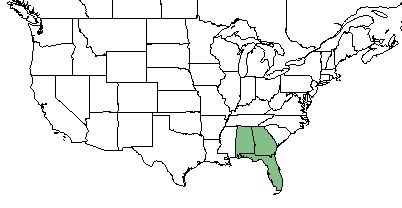Difference between revisions of "Eustachys floridana"
(→Ecology) |
Juliec4335 (talk | contribs) |
||
| Line 35: | Line 35: | ||
Associated species include ''Pinus palustris'', ''Pinus taeda'', ''Aristida'' sp., ''Croptilion'' sp., ''Liatris'' sp., ''Eupatorium'' sp., and ''Tridens'' sp.<ref name= "FSU herbarium"/> | Associated species include ''Pinus palustris'', ''Pinus taeda'', ''Aristida'' sp., ''Croptilion'' sp., ''Liatris'' sp., ''Eupatorium'' sp., and ''Tridens'' sp.<ref name= "FSU herbarium"/> | ||
| + | |||
| + | ''Eustachys floridana'' is frequent and abundant in the North Florida Longleaf Woodlands community type as described in Carr et al. (2010).<ref>Carr, S.C., K.M. Robertson, and R.K. Peet. 2010. A vegetation classification of fire-dependent pinelands of Florida. Castanea 75:153-189.</ref> | ||
===Phenology===<!--Timing off flowering, fruiting, seed dispersal, and environmental triggers. Cite PanFlora website if appropriate: http://www.gilnelson.com/PanFlora/ --> | ===Phenology===<!--Timing off flowering, fruiting, seed dispersal, and environmental triggers. Cite PanFlora website if appropriate: http://www.gilnelson.com/PanFlora/ --> | ||
Revision as of 13:50, 17 July 2020
Common name: twospike fingergrass [1], Florida fingergrass [2]
| Eustachys floridana | |
|---|---|
| Scientific classification | |
| Kingdom: | Plantae |
| Division: | Magnoliophyta - Flowering plants |
| Class: | Liliopsida - Moncots |
| Order: | Poales |
| Family: | Poaceae |
| Genus: | Eustachys |
| Species: | E. floridana |
| Binomial name | |
| Eustachys floridana Chapm. | |

| |
| Natural range of Eustachys floridana from USDA NRCS Plants Database. | |
Contents
Taxonomic Notes
Synonyms: Chloris floridana (Chapman) Wood
Varieties: none
Description
E. floridana is a perennial graminoid of the Poaceae family native to North America.[1] It generally reaches heights of between 4 and 10 dm tall with slender stems.[3]
Distribution
E. floridana is found in Alabama, Georgia, and Florida.[1] Within this range, it is found from eastern Georgia south to central peninsular Florida and west to the western panhandle of Florida and southern Alabama.[2]
Ecology
Habitat
E. floridana proliferates in sandhills and pine flatwoods[2], as well as pine rocklands and marl prairies.[4] Specimens have been collected from open oak woods, open longleaf sandhill, flatwoods, and wiregrass sandhill communities.[5] It is considered an indicator species of the north Florida longleaf woodlands habitat.[6] Thinning the overstory has a negative effect on the abundance of E. floridana but this species was found to persist with clearcutting disturbance.[7]
Associated species include Pinus palustris, Pinus taeda, Aristida sp., Croptilion sp., Liatris sp., Eupatorium sp., and Tridens sp.[5]
Eustachys floridana is frequent and abundant in the North Florida Longleaf Woodlands community type as described in Carr et al. (2010).[8]
Phenology
E. floridana is a perennial herb to 1 m tall; raceme rachis wingless, triangular, fertile lemma pale or gray. [4]
Seed dispersal
This species is thought to be dispersed by wind. [9]
Fire ecology
It occurs in habitats that are fire-dependent.[6]
Conservation and Management
Cultivation and restoration
Photo Gallery
References and notes
- ↑ 1.0 1.1 1.2 USDA Plant Database https://plants.usda.gov/core/profile?symbol=EUFL3
- ↑ 2.0 2.1 2.2 Weakley, A. S. (2015). Flora of the Southern and Mid-Atlantic States. Chapel Hill, NC, University of North Carolina Herbarium.
- ↑ [[1]] NatureServe Explorer. Accessed: May 13, 2019
- ↑ 4.0 4.1 Coile, N. C. (2000). Notes on Florida �s Regulated Plant Index (Rule 5B-40), Botany Contribution No. 38, 3nd edition. Gainesville, Florida, Florida Deaprtment of Agriculture and Consumer Services, Division of Plant Industry.
- ↑ 5.0 5.1 URL: http://herbarium.bio.fsu.edu. Last accessed: June 2018. Collectors: R. Kral, Loran C. Anderson, H. Kurz, R.K. Godfrey, J. P. Gillespie, R.E. Perdue, Richard Carter, W.W. Baker. States and counties: Florida (Wakulla, Madison, Leon, Suwannee) Georgia (Thomas, Baker)
- ↑ 6.0 6.1 Carr, S. C., et al. (2010). "A Vegetation Classification of Fire-Dependent Pinelands of Florida." Castanea 75(2): 153-189.
- ↑ Brockway, D. G. and C. E. Lewis (2003). "Influence of deer, cattle grazing and timber harvest on plant species diversity in a longleaf pine bluestem ecosystem." Forest Ecology and Management 175: 49-69.
- ↑ Carr, S.C., K.M. Robertson, and R.K. Peet. 2010. A vegetation classification of fire-dependent pinelands of Florida. Castanea 75:153-189.
- ↑ Kirkman, L. Katherine. Unpublished database of seed dispersal mode of plants found in Coastal Plain longleaf pine-grasslands of the Jones Ecological Research Center, Georgia.